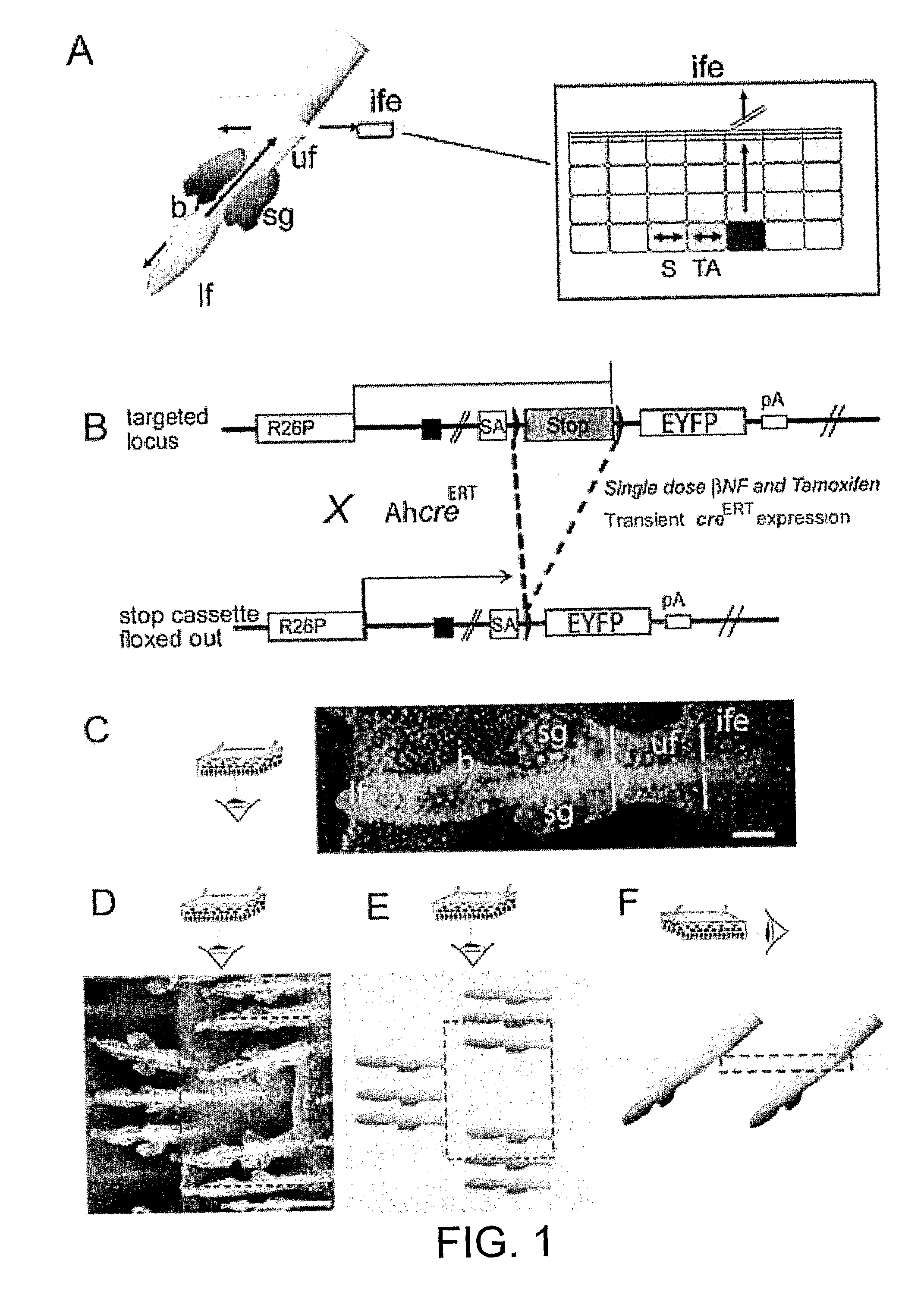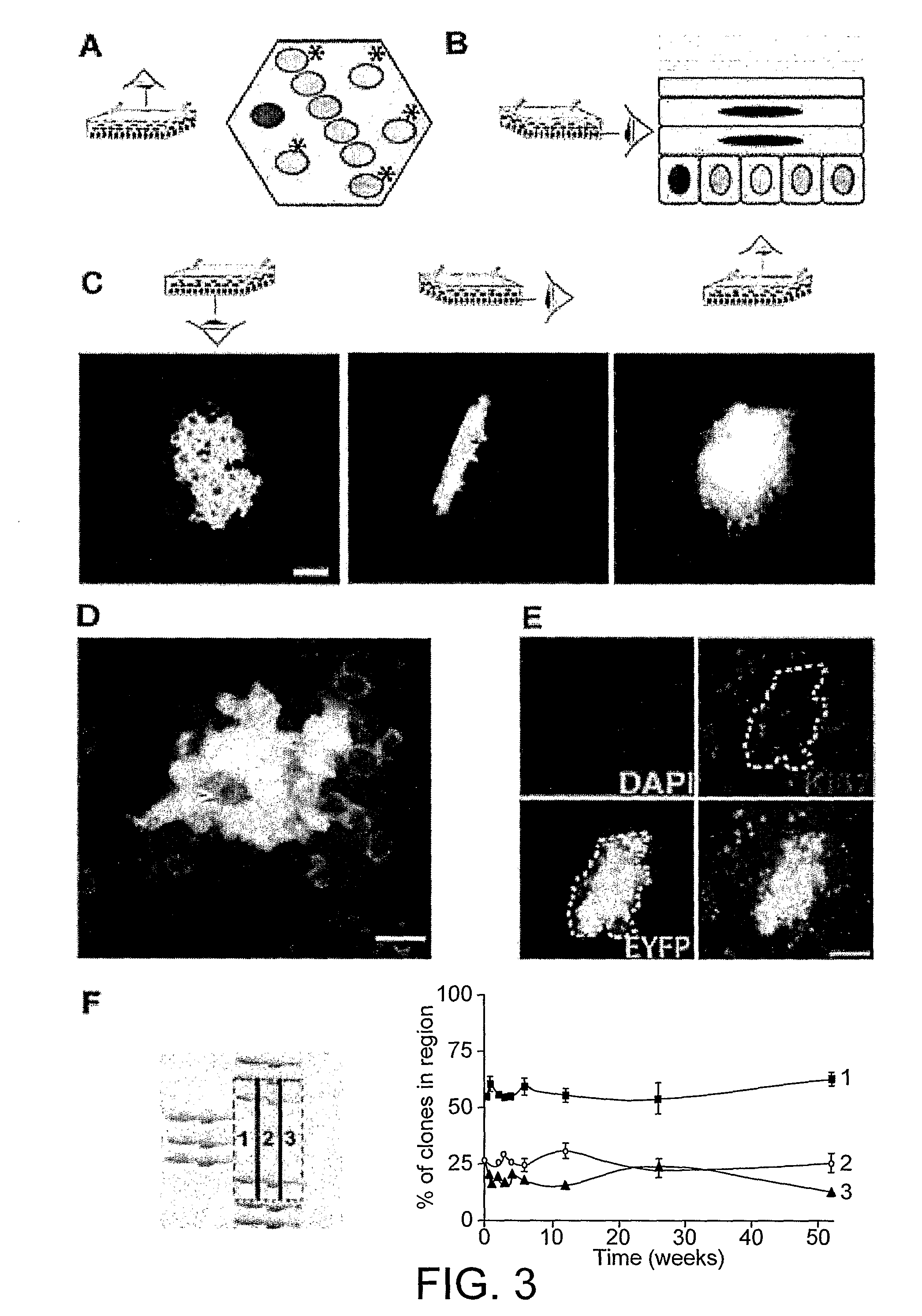Methods of Analysing Cell Behaviour
a cell behaviour and cell technology, applied in the field of cell behaviour and cell behaviour research, can solve the problems of bulge stem cells not supporting it is not known whether bulge stem cells actually support the other pools of stem cells found in the epidermis, and the prior art has not been able to address this question. , to achieve the effect of stable expression of the marker
- Summary
- Abstract
- Description
- Claims
- Application Information
AI Technical Summary
Benefits of technology
Problems solved by technology
Method used
Image
Examples
example 1
Imaging a Clonal Cell Line in a Test Animal
[0146]Mice transgenic for an inducible form of cre recombinase (AhcreERT) were crossed onto the R26EYFP / EYFP reporter strain in which a conditional allele of Enhanced Yellow Fluorescent Protein (EYFP) has been targeted to Rosa26 locus by homologous recombination (FIG. 1B, Kemp et al (2004) Nucleic Acids Res 32, e92; Srinivas et al (2001) BMC Dev Biol 1, 4). In the resultant AhcreERT R26EYFP / wt heterozygote animals, EYFP is expressed in the epidermal cells following a single injection of βNF and tamoxifen at 6-9 weeks of age. At intervals after induction, mice were sacrificed for analysis. Cells expressing EYFP (EYFP+) and their EYFP+ progeny were detected by confocal microscopy and reconstruction of wholemount epidermis, in which the entire epidermis is detached from the underlying dermis, allowing all cells in the tissue to be imaged at single cell resolution (Braun et al (2003) Development 130, 5241-5255). In this study we used tail skin...
example 2
Inducible Clonal Targeting in Adult Mouse Epidermis
[0165]We show a system that allows the controlled induction of specific mutations in individual epidermal cells in a wild type background, and enables the mutated clones and their progeny to be followed over an extended period. To do this we exploited a transgenic mouse line (AhcreERT) which expresses a tamoxifen regulated ere reeombinase-mutant oestrogen receptor fusion protein under the control of the CYPA1A promoter (Kemp et al. 2004). CYPA1A is normally tightly repressed, out is induced following administration of the non genetoxic xenobiatic B-napthoflavone (B-NF) in several tissues including the epidermis and the squamous oesophagus. Dual transcriptional and post-translational control of cre expression results in no detectable background recombination in adult epidermis in the absence of treatment with the inducing drugs. High doses of the inducing drugs result in widespread recombination in the upper hair follicle and interfo...
example 3
Clonal Modelling of Cancer
[0178]Cancer is hypothesised to evolve from oncogenic mutation in individual progenitor cells in a background of wild type cells. The mouse model system described above is ideally suited to test this hypothesis in the epidermis and analyse the changes to clonal behaviour that occur during tumour development.
Development of a Clonal Model of Basal Cell Carcinoma
[0179]Basal cell carcinoma (BSC) is the commonest career in Caucasians in the western world. It can cause significant morbidity through local invasion at the tumour site and requires treatment with surgery, cryoablation or radiotherapy. BCC development is linked strongly to over activation of the Hedgehog (HH) signalling pathway. HH ligands, including Sonic Hedgehog (SHH) bind to a transmembrane receptor Patched (PTCH, 1 on FIG. 9). Ligand binding relieves the inhibition of a second transmembrane protein, Smoothened (SMO), by Patched (2). Derepression of Smoothened leads to Gli transcription factors, h...
PUM
| Property | Measurement | Unit |
|---|---|---|
| time | aaaaa | aaaaa |
| time | aaaaa | aaaaa |
| time | aaaaa | aaaaa |
Abstract
Description
Claims
Application Information
 Login to View More
Login to View More - R&D
- Intellectual Property
- Life Sciences
- Materials
- Tech Scout
- Unparalleled Data Quality
- Higher Quality Content
- 60% Fewer Hallucinations
Browse by: Latest US Patents, China's latest patents, Technical Efficacy Thesaurus, Application Domain, Technology Topic, Popular Technical Reports.
© 2025 PatSnap. All rights reserved.Legal|Privacy policy|Modern Slavery Act Transparency Statement|Sitemap|About US| Contact US: help@patsnap.com



